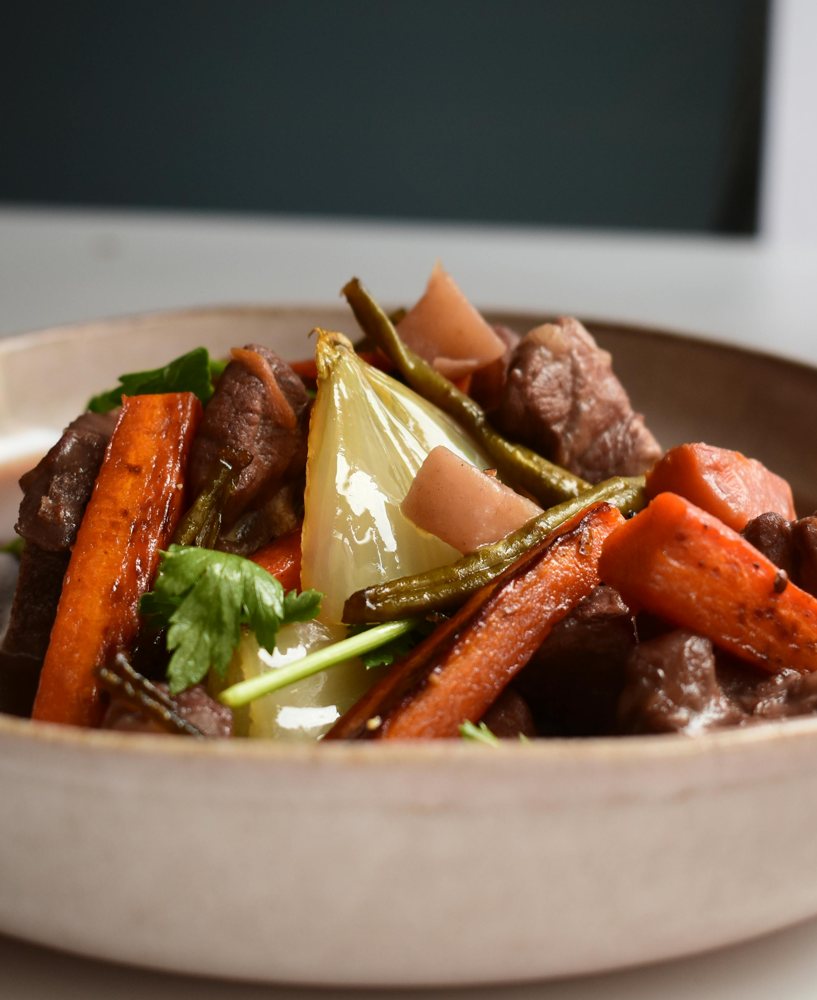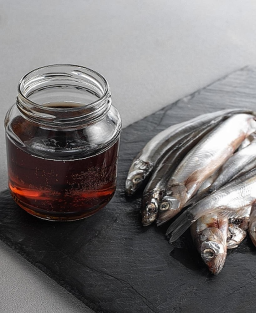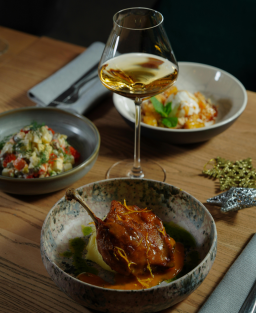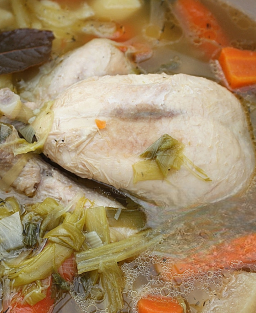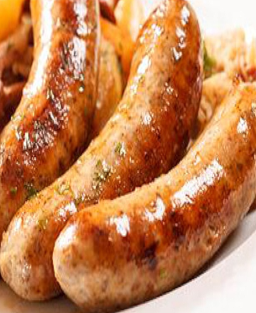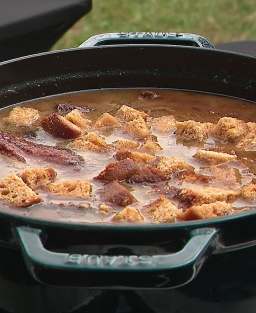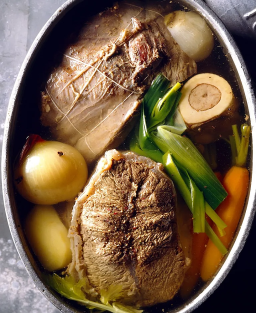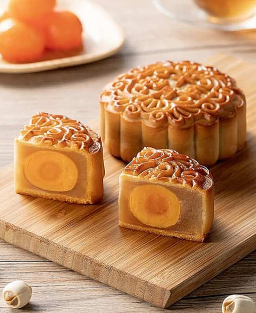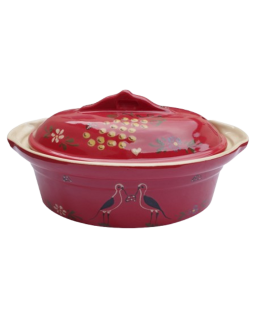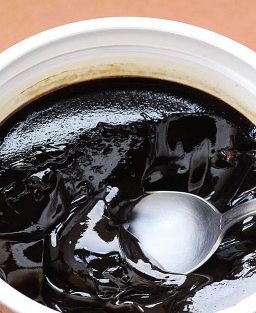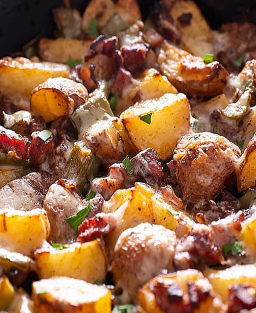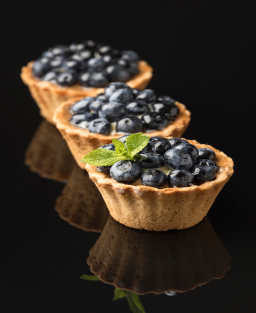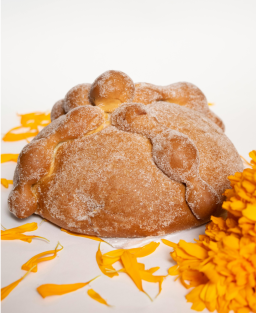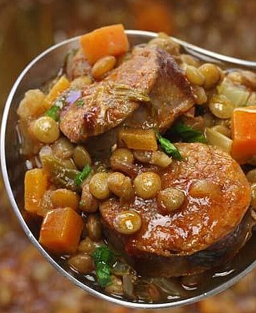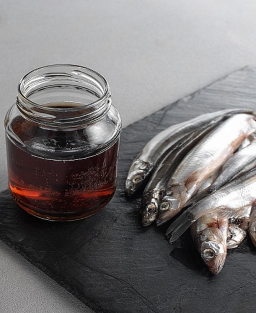Royal Venison Stew – Heritage of French Game Cuisine
Royal Venison Stew – Heritage of French Game Cuisine
Discover the traditional recipe for royal venison stew, a noble and festive game dish, slow-cooked with red wine, bacon, aromatics, and foie gras reduction.
Anecdote
At the beginning of the 18th century, during a grand hunting banquet organized by the Duke of Burgundy, venison was served with a smooth sauce enriched with foie gras, accompanied by fine garnishes of mushrooms and bacon. According to culinary chronicles, the young duke, enamored with a lady from the neighboring court, was so captivated by the delicacy of the dish that he declared it “more worthy of a loving heart than of a simple table.”
In another version, Louis XV, known for his refined taste and pleasures of the table, had a marked preference for this stew, especially during hunts in Sologne. Tradition says he personally requested that his chef ensure the game was carefully cooked, draped with foie gras sauce, and served elegantly, to impress his guests and transform the meal into a true celebration of table art and seduction.
Legend
It is said that some royal meals in Sologne or Burgundy included a slowly simmered venison stew, covered with red wine and foie gras sauce, symbolizing generosity and elegance. Lords and kings of the time particularly appreciated the aromatic richness and tenderness of the meat, often accompanied by simple yet refined garnishes.
Necessary Utensils
-
Enameled cast-iron casserole with tight-fitting lid
-
Chef’s knife and paring knife
-
Stable cutting board
-
Silicone spatula and wooden spoon
-
Ladle and sauce spoon
-
Fine sieve or chinois
-
Professional or domestic oven
-
Pan for pre-sautéing mushrooms
Origin
-
Country: France
-
Region: Burgundy / Sologne
-
Inventor: Oral transmission, gradually codified by classical chefs
-
Codified recipe: Yes
Specifications
-
Selected and marinated venison
-
Long sauce reduced with red wine, broth, and aromatics
-
Optional liaison with foie gras for creaminess
-
Served hot, coated with shiny sauce
Historical Background
Royal venison stew finds its origins in 17th-century French haute cuisine, when game meals reflected both the wealth and power of the nobility and the skill of the chefs. Initially, venison was a highly prized hunting delicacy, and its preparation followed strict codifications in royal and noble kitchens.
17th Century – Beginnings
Louis XIII (1601–1643) and Louis XIV (1638–1715) were known game enthusiasts, and their royal kitchens at Versailles documented venison stews simmered in red wine with aromatics.
The first mentions of “royal venison” appear in François Pierre La Varenne’s manuscripts, notably in Le Cuisinier François (1651), describing game stews with reduction and sauce liaison.
At this time, venison was often accompanied by noble garnishes such as bacon, mushrooms, and rare spices (cloves, nutmeg), reserved for court feasts.
18th Century – Refinement and Prestige
Under Louis XV (1710–1774), royal venison became an emblematic dish for winter banquets and grand hunts in Sologne and Burgundy.
Grimod de La Reynière (1758–1837) notes in his writings the sovereigns’ preference for slowly simmered game stews with smooth sauces, often enriched with foie gras or cream, for a more refined flavor.
Royal chefs began codifying techniques: browning the meat, reducing wine, binding with butter or foie gras, slow cooking in closed casseroles to preserve juices.
19th Century – Codification by Master Chefs
Antonin Carême (1784–1833), considered the first “modern grande cuisine chef,” perfected royal venison: recommending red wine marinade, sautéing bacon and vegetables, flambéing with cognac, and binding the sauce with foie gras for richness and creaminess.
Jules Gouffé (1807–1877) introduced sautéed mushrooms and refined the aromatic garnish, favoring a subtle balance between wine acidity and vegetable sweetness.
Auguste Escoffier (1846–1935) codified the recipe in his Guide Culinaire (1903): emphasizing precise cooking, uniform coating, and perfect sauce reduction, allowing the venison flavor to be enhanced while maintaining tender texture.
19th–20th Centuries – Sovereigns and Preferences
Napoleon I (1769–1821), fond of game, reportedly preferred royal venison accompanied by mushrooms and a robust Bordeaux wine, believing the sauce should be rich but balanced.
Under Louis-Philippe (1773–1850), hunting banquets at Fontainebleau served venison stews with reduced red wine and fine aromatics, garnished with foie gras to impress guests and affirm royal prestige.
These dishes also appeared in bourgeois and aristocratic feasts, becoming symbols of refinement and French gastronomy.
Culinary Evolution and Modernization
In the 20th century, the recipe adapted to professional and domestic kitchens. Slow oven cooking, clear yet coating sauces, and the use of veal or poultry stock to enhance flavors became preferred.
Royal venison retains its nobility, but garnishes may vary: creamy potatoes, glazed vegetables, or fresh tagliatelle.
Today, royal venison stew remains a festive emblematic dish, combining tradition, historical expertise, and aromatic richness.
Recipe Description
This slow-cooked game dish combines the richness of venison with the aromatic depth of bacon, robust red wine, and vegetables. The foie gras-bound sauce provides a smooth and glossy texture, perfect for accompanying purées, seasonal vegetables, or fresh pasta.
Ingredients (for 4 to 6 people)
-
1.5 kg venison (shoulder or leg)
-
150 g smoked bacon
-
2 onions
-
2 carrots
-
2 garlic cloves
-
1 bouquet garni (thyme, bay leaf, parsley)
-
75 cl robust red wine (Bordeaux, Cahors)
-
50 cl poultry or game stock
-
2 tbsp sifted flour
-
50 g butter
-
2 tbsp olive oil
-
2 tbsp cognac
-
200 g button mushrooms
-
1 tbsp tomato paste
-
Salt and pepper
Detailed Preparation
1. Marinade (the day before)
Selection and cutting: choose tender, high-quality venison pieces (shoulder or leg), free of nerves and excess fat. Cut into uniform large cubes for even cooking.
Preparation of aromatic vegetables: peel and cut carrots into regular slices. Finely slice onions and lightly crush garlic cloves to release aromas.
Marinade assembly: place meat and vegetables in a large bowl. Add bouquet garni and pour enough red wine to cover the meat.
Rest and infusion: cover with cling film or tight-fitting lid. Refrigerate for 24 hours, stirring occasionally. This step tenderizes the meat and enhances game aromas.
2. Preparing the Meat
Draining and drying: remove meat and vegetables from marinade. Pat dry with paper towels to prevent steaming and favor browning.
Sautéing the meat: heat butter and olive oil in a heavy casserole. Brown venison over medium-high heat until golden on all sides, developing juices and aromas. Set aside on a warm plate.
Sautéing the bacon: in the same casserole, lightly brown bacon to add depth and smoky notes.
Cooking the vegetables: add carrots, onions, and garlic from the marinade. Sweat gently over low heat without excessive browning to release natural sugars while retaining sweetness.
3. Cooking the Stew
Reassembling the dish: return meat to the casserole. Sprinkle with sifted flour and mix well to coat (“singer”), which will help bind the sauce.
Flambé: pour cognac over meat and ignite carefully to concentrate aromas and burn off alcohol.
Adding liquids and aromatics: add marinade wine, stock, tomato paste, and bouquet garni. Bring to a boil, scraping the bottom to lift browned bits.
Slow simmering: reduce heat, cover, and cook for 3 hours over low heat until meat is tender and flavors meld. Stir occasionally and skim if needed.
4. Adding Mushrooms
Preparation: clean and cut mushrooms into quarters or slices.
Sautéing: quickly sauté with a little butter until lightly golden to concentrate flavor.
Incorporation: add to stew 30 minutes before the end of cooking to absorb sauce while maintaining firmness.
5. Foie Gras Reduction Sauce
Shallot: finely chop to integrate smoothly into the sauce.
Melting and sweating: melt butter in a small saucepan and sauté shallot until translucent.
Wine reduction: add red wine or port and reduce by half to concentrate flavor.
Adding veal stock: incorporate stock and reduce gently to slightly syrupy consistency.
Foie gras integration: cut foie gras into small pieces and add off heat. Mix gently for a smooth, glossy texture.
Finishing: add cream and adjust seasoning with salt and pepper. Sauce should be smooth, coating, and flavorful.
6. Service
Plating: place meat on a dish or directly on plates. Generously coat with foie gras reduction sauce.
Accompaniments: mashed potatoes, fresh tagliatelle, seasonal vegetables, or classic game garnishes.
Decoration: add chopped fresh herbs or truffle slices for a gastronomic touch.
Regional Versions and Variations
-
Burgundy: Burgundy wine and smoked bacon
-
Gascony: Madiran wine, goose fat, pink Lautrec garlic
-
Modern: Port reduction, no flour, finished with butter
Tips and Tricks
-
Flambé cognac to concentrate aromas
-
Avoid overcooking sauce after reduction, it may become bitter
-
Always strain sauce through a chinois for smooth, glossy texture
Recommended Wines and Drinks
-
France: Bordeaux, Châteauneuf-du-Pape, Pomerol
-
Spain: Rioja Gran Reserva
-
Italy: Barolo, Brunello di Montalcino
-
Non-alcoholic: concentrated black grape juice or Lapsang Souchong smoked tea
Nutritional Information (per 100 g)
| Element | Value |
|---|---|
| Energy | 210 kcal / 879 kJ |
| Fat | 12 g |
| Carbohydrates | 3 g |
| Protein | 18 g |
| Fiber | 0.8 g |
| Allergens | Possible gluten (if wheat flour used) |
Glossary
-
Sweat: cook gently to release aromas without browning
-
Singer: sprinkle with flour to bind a sauce
-
Deglaze: dissolve browned bits with liquid (wine, stock)
-
Napper: evenly coat food with sauce
-
Brown roux: cooked mixture of flour and fat used to thicken sauces
-
Flambé: ignite alcohol to burn off and concentrate aromas







